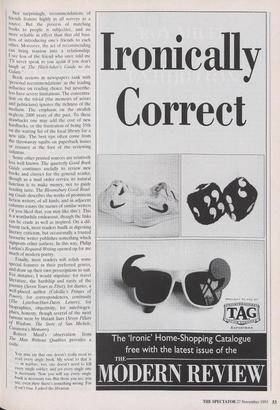Finding books to read
anything to read'. Compared with, say, films or music, modern literature is suprisingly ill-served with overviews for the man in the street. Yet a good deal of information to guide reading habits is available, if you know where to look for it.
Surveys show that most people look for something to read in one of two ways: for books which are known, through authors names; or for books which are not, through browsing. For the browser, the choice of venue lies essentially between bookshop and library. The view that a bookshop's shelves display everything that is worth reading, whilst a library's contain a residue of what is not (since all the worthwhile titles have been borrowed) is too crude to deserve attention. But whether their brows- ing pasture, is library or bookshop, readers will seek a place where the stock is respon- sibly maintained, not ravaged by time, use, fashion, or sneak thieves.
Browsing techniques vary greatly. About 30 per cent of fiction readers, for instance, claim to be influenced by a book's cover: another 22 per cent by the title (some pre- ferring the use of a comma — as in Farewel4 My Lovely). Quite a number of people, including fully sighted readers, avoid small print — although many paper- back publishers are too short-sighted to notice this. Nearly a third of readers are influenced by the height of the shelf, with bifocals blurring the top row, and the bottom row ruled out by a gamut of medi- cal complaints (bad backs, arthritis, dizzi- ness, etc). Surprisingly, for two thirds of library users literary style is not a preoccupation, though when it is impor- tant, sampling of the text is taken to sophis- ticated lengths. But by far the biggest influence of choice — affecting 88 per cent of cases — is the blurb on the book's cover. For those who will not stoop to blurbs, there is sometimes persuasive force in the one-line, back cover eulogies by well known writers.
The bad news for browsers is that books chosen through browsing seem less likely to be a success. According to another survey, only one out of three browsing choices are `positively enjoyed', compared with four out of five author-based choices.
Some library users are drawn to books which they know have already been read (though not necessarily enjoyed) by other people. This is why library users haunt the returned books shelves. (An astonishing 46 per cent of the borrowed books in one survey sample had been found in this way.) Scrutiny of the best-seller lists will reveal what is currently being bought in large quantities, and probably enjoyed too --- investment dictating a more careful choice. And the Registrar of Public Lending Right periodically releases from his secret archives lists of the hundred most loaned books in public libraries across the country (often subtly different from the titles In best-seller lists).
Not surprisingly, recommendations of friends feature highly in all surveys as a source. But the process of matching books to people is subjective, and no more reliable in effect than that old busi- ness of introducing one's friends to each other. Moreover, the act of recommending can bring tension into a relationship. I see less of the friend who once told me I'll never speak to you again if you don't laugh at The Hitch-hiker's Guide to the Galaxy.'
Book reviews in newspapers rank with personal recommendations' as the leading influence on reading choice, but neverthe- less have severe limitations. The concentra- tion on the trivial (the memoirs of actors and politicians) ignores the richness of the medium. The emphasis on the modish neglects 2000 years of the past. To these drawbacks one may add the cost of new hardbacks, or the frustration of being 35th on the waiting list of the local library for a new title. The best tips often come from the throwaway squibs on paperback issues or reissues at the foot of the reviewing Columns.
Some other printed sources are relatively less well known. The quarterly Good Book Guide continues usefully to review new books and classics for the general reader, though as a mail order service its natural function is to make money, not to guide reading taste. The Bloomsbury Good Read- ing Guide describes the works of prominent fiction writers, of all kinds, and in adjacent columns essays the names of similar writers Cif you liked that, you may like this'). This is a worthwhile endeavour, though the links can be crude as well as inspired. On a dif- ferent tack, most readers baulk at digesting literary criticism, but occasionally a trusted favourite writer publishes something which signposts other authors. In this way, Philip Larkin's Required Writing opened up for me much of modern poetry.
Finally, most readers will relish some special features in their preferred genres, and draw up their own prescriptions to suit. For instance, I would stipulate: for travel literature, the hardship and rarity of the Journey (Seven Years in Tibet); for diaries, a well-placed author (Colville's Fringes of Power); for correspondences, continuity (The LytteltonlHart-Davis Letters); for biographies, objectivity; for autobiogra- phies, honesty, though several of the most famous were by blatant liars (Seven Pillars of Wisdom, The Story of San Michele, Casanova's Memoirs). Robert Musil's observation from he Man Without Qualities provides a coda:
You may say that one doesn't really need to read every single book. My retort to that is — in warfare, too, one doesn't need to kill every single soldier, and yet every single one IS necessary. Now you will say every single book is necessary too. But there you are, you see, even there there's something wrong. For it isn't true. I asked the librarian.











































































 Previous page
Previous page